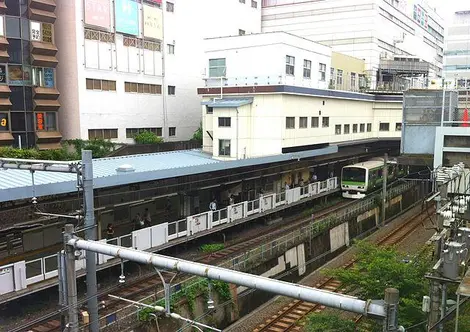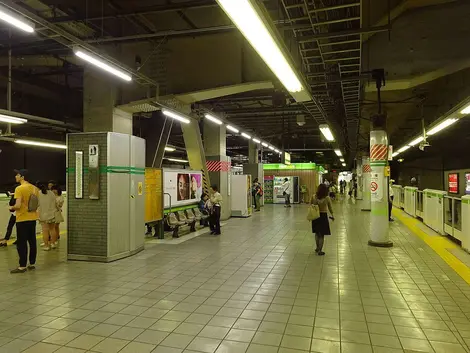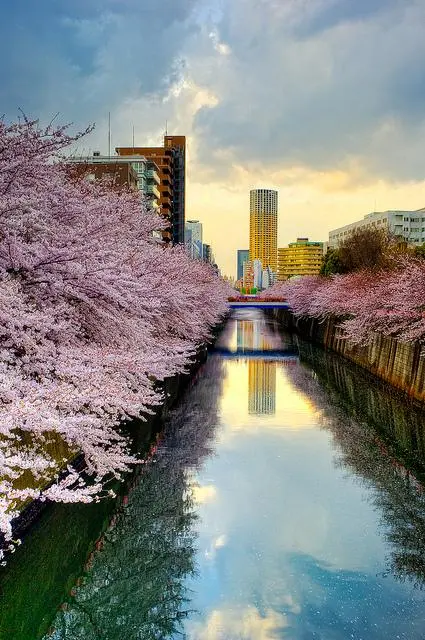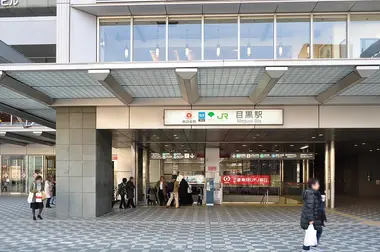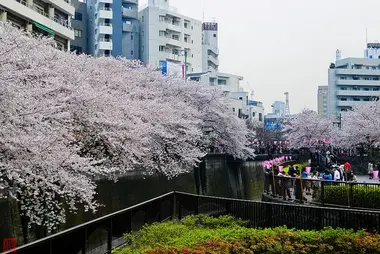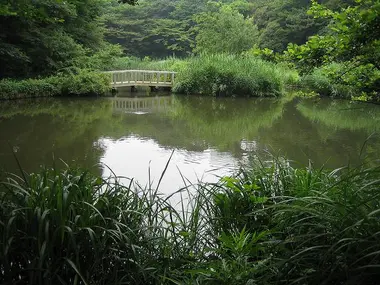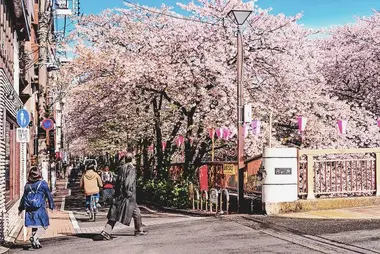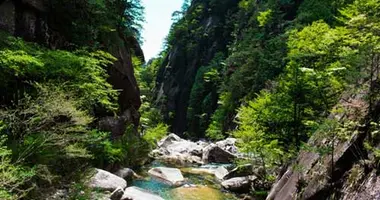Meguro station
In the heart of Tokyo, Meguro station stands as a neuralgic point linking residential calm to urban effervescence. Located on the famous Yamanote line, it offers privileged access to quiet neighborhoods while remaining close to the capital's liveliest areas. Opened in 1885, this historic station has evolved into a major crossroads served by four railway lines. With over 100,000 passengers a day, Meguro is much more than just a station: it's a gateway to authentic Tokyo, where tradition and modernity blend harmoniously.
Meguro station overview
Meguro station, or 目黒駅 (Meguro-eki) in Japanese, is located in Shinagawa district, on the border of Meguro district. This strategic location makes it an important junction between southern and central Tokyo. Built on several levels, the station comprises an underground section and an above-ground section, with an Atré shopping mall on the upper floors.
The station features a modern, functional structure designed to facilitate passenger flow. It has three main exits: the main exit, the west exit and the east exit, all in close proximity to each other. This compact layout makes it easy for passengers to find their way around and quickly access the various points of interest in the area.
Despite its heavy traffic, Meguro station retains a relatively calm atmosphere, reflecting the residential and family character of the surrounding area. It's a transit point that offers a smooth transition between the hustle and bustle of the city center and the tranquility of the outlying areas.
Train services to Meguro station
Meguro station is served by four major rail lines, making it an essential transportation hub in Tokyo's network:
1. The Yamanote line (JR East): Tokyo's iconic circular line connects the city's main centers of activity. In Meguro, it offers direct connections to major stations such as bustling Shibuya (just two stops away) and Shinjuku.
2. Namboku line (Tokyo Metro): This subway line crosses Tokyo from north to south, offering connections with the Yamanote at several points, including Komagome.
3. Mita line (Toei): Operated by the Tokyo Metropolitan Transport Bureau, this line connects Meguro with more northerly districts such as Sugamo.
4. Tokyu Meguro line: Operated by the private company Tokyu, this line connects Meguro with the city of Yokohama, passing through popular residential areas.
The station's layout reflects this diversity of lines. Level -1 (B1F) houses the platforms of the Yamanote line, while the other three lines are grouped together in the 4th basement (B4F). This organization enables efficient interconnection between the different services, facilitating connections for passengers.
History and development of the station
The history of Meguro station dates back to the Meiji era, to March 16, 1885, when it was inaugurated. At the time, it served only the line that would later become the Yamanote, playing a crucial role in the urban development of this part of Tokyo.
Over the decades, the station underwent several phases of expansion and modernization to meet the changing transport needs of the growing capital. The successive addition of the Tokyu Meguro, Namboku and Mita lines considerably increased its importance in Tokyo's rail network.
A key moment in the station's recent history was the integration of the Atré shopping mall into its structure, transforming the station into a truly multifunctional complex. This development reflects a broader trend in Japan to make stations not just places of transit, but also spaces for living and consumption.
Today, with over 100,000 daily passengers, Meguro station has established itself as one of the major stations on the Yamanote line, playing a crucial role in Tokyo's urban mobility.
Station structure and organization
Meguro station has a multi-level structure, designed to optimize passenger flow and facilitate connections between different lines:
- Level -1 (B1F): Dedicated to the Yamanote line, this level comprises two side platforms. Platform 1 serves the Shibuya/Shinjuku direction, while platform 2 leads to Shinagawa/Ueno.
- Level -4 (B4F): This level houses the other three lines (Namboku, Mita and Tokyu Meguro). Because of their terminus status at Meguro, these lines share two platforms for departures and arrivals.
The station has three main exits, all within easy reach of each other:
- Main exit: Ideal for accessing the Meguro River and Daien-ji temple.
- East exit: Recommended for the Tokyo Teien Metropolitan Museum of Art and the Nature Study Institute Park.
- West exit: leading to other residential and commercial areas.
Above the station is the Atré shopping center, offering a variety of stores and restaurants. This integration of commercial spaces into the station structure is typical of large Japanese stations, transforming transit areas into real living spaces.
To facilitate accessibility, the station is equipped with elevators and escalators linking the different levels. Clear information panels and multilingual announcements guide passengers, making the station easy to navigate even for foreign visitors.
Meguro district: attractions and points of interest
The Meguro district, although less well-known to tourists than other areas of Tokyo, has many treasures to discover:
Nature Study Institute (Shizen-Kyoiku-En): Located near the station, this vast 200,000 m² park offers a green oasis in the heart of Tokyo. It's an ideal place to observe local flora and fauna, with numerous walking trails and relaxation areas.
Tokyo Teien Metropolitan Museum of Art: a former princely residence transformed into a museum, this 1933 art deco building houses remarkable art collections. Its elegant gardens make it a particularly pleasant place to visit.
Daien-ji temple: Founded in 1624, this Buddhist temple is famous for its 519 rakan statues (disciples of Buddha). These statues, intended to soothe the souls of victims of a historic fire, are a striking sight.
Meguro Gajo-en: This impressive 1928 building, renovated in 1988, houses an art gallery, restaurants, hotel and gardens. It is particularly popular for wedding ceremonies.
These attractions, combined with the district's peaceful, residential atmosphere, make Meguro a prime destination for those seeking to discover a more authentic, less touristy Tokyo.
The Meguro River and its famous cherry trees
The Meguro River, which runs through the district of the same name, is undoubtedly the area's star attraction, especially in spring. Bordered by nearly 800 cherry trees over a distance of 3.8 kilometers, it offers an enchanting spectacle during hanami, the cherry blossom season.
During this period, generally from late March to early April, the banks of the river are transformed into a veritable tunnel of pink blossoms. This phenomenon attracts thousands of visitors who come to admire this ephemeral spectacle and take part in the accompanying festivities. The branches of the cherry trees, gracefully overhanging the water, create an almost magical atmosphere, particularly popular for photos.
The annual Nakameguro Cherry Festival is a highlight of the season. The trees are illuminated in the evening, offering a unique visual experience. Food and drink stalls line the riverbanks, creating a festive and convivial atmosphere.
Outside the cherry season, the Meguro River remains a pleasant place to stroll. Its landscaped banks are a popular place for local residents to relax. It's an ideal place to stroll, jog or simply relax while enjoying a bit of nature in the heart of the city.
Comparison with neighboring Naka-Meguro station
Although geographically close, Meguro and Naka-Meguro stations have distinct characteristics that make them complementary in Tokyo's urban landscape:
Size and ridership: Meguro station, served by the Yamanote line, is generally busier, with100,000 passengers a day. Naka-Meguro, though popular, is less busy.
Atmosphere: Naka-Meguro is renowned for its more bohemian, trendy atmosphere, with numerous cafés, independent boutiques and art galleries. Meguro, on the other hand, has a more family-oriented, residential feel.
Attractions: While Meguro is known for its historic sites such as Daien-ji temple, Naka-Meguro is famous for its cherry orchards along the Meguro River, attracting large crowds during the blossoming season.
Connections: Meguro offers connections to more lines, notably the Yamanote, making it a more important transportation hub. Naka-Meguro is served mainly by the Tokyu Toyoko and Tokyo Metro Hibiya lines.
Commercial development: The area around Naka-Meguro has seen more recent and trendy commercial development, with the opening of Nakameguro Koukashita, a complex under the railroad tracks featuring cafés, restaurants and the Tsutaya Books bookshop.
In short, while Meguro is positioned as a major station offering essential connections and access to historic sites, Naka-Meguro has forged a reputation as a hip and picturesque neighborhood, particularly popular with young Tokyoites and visitors seeking a more local and trendy experience.



